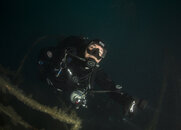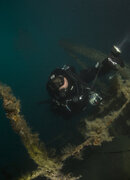WS007
Contributor
When you photograph an entire wreck, you cannot illuminate the entire scene with strobes. At most single spots of the scenery with remote strobe(s). Here the sensor size contributes to better image (less noise at higher ISO), but 60m is really deep and there will be little light. Another factor then is the aperture - the wider open the better. This is a classical application for a FF camera and WA water contact optics (e.g. Nauticam WACP or FCP) - large sensor plus wide aperture - and the difference in IQ compared to a compact camera will be substantially. That does not mean that you cannot make nice photos with a compact camera as well...
You second scenario is inside the wreck and light comes mostly from strobes (also her preferentially remote strobes, otherwise you will get a lot of backscatter from floating particles). Here the sensor size makes a smaller difference, when you manage to light your scenery well with the strobes...
=> I think that the difference in IQ between a GoPro and an "edulis" compact (e.g. Sony RX100) with high quality water contact optics for WA (e.g. Nauticam WWL-C) and two (or even more) good strobes will be enormous, like night and day.
My recommendation would be that you start with this now and after a couple of years, when you know exactly what you want, you reconsider...
Wolfgang
You second scenario is inside the wreck and light comes mostly from strobes (also her preferentially remote strobes, otherwise you will get a lot of backscatter from floating particles). Here the sensor size makes a smaller difference, when you manage to light your scenery well with the strobes...
=> I think that the difference in IQ between a GoPro and an "edulis" compact (e.g. Sony RX100) with high quality water contact optics for WA (e.g. Nauticam WWL-C) and two (or even more) good strobes will be enormous, like night and day.
My recommendation would be that you start with this now and after a couple of years, when you know exactly what you want, you reconsider...
Wolfgang







